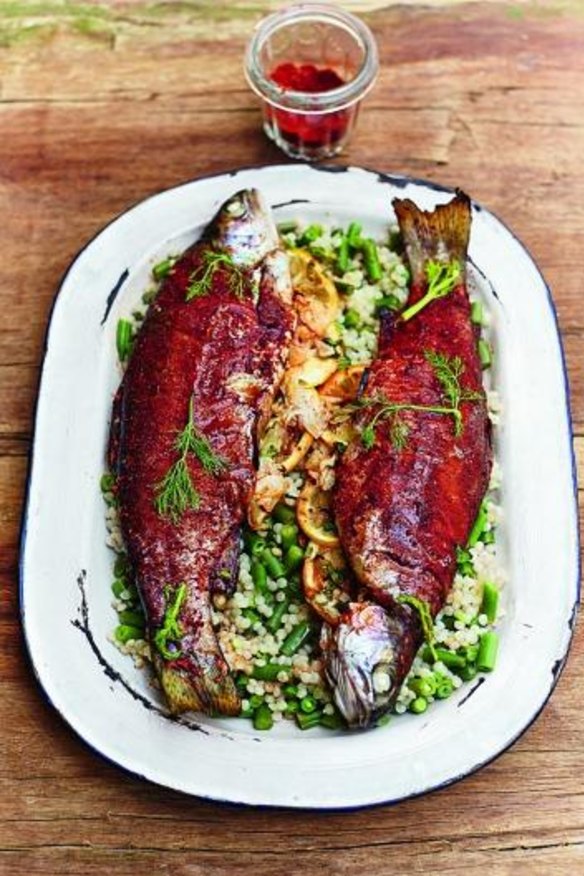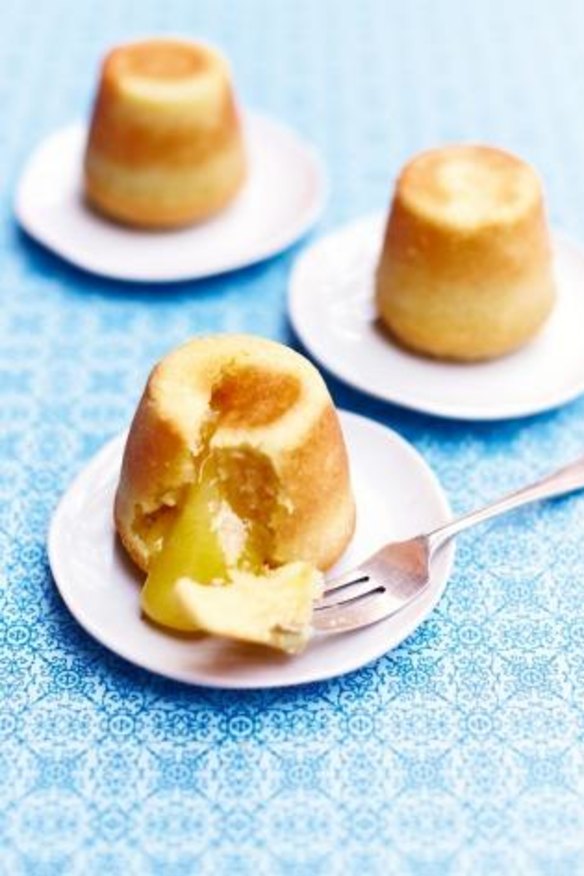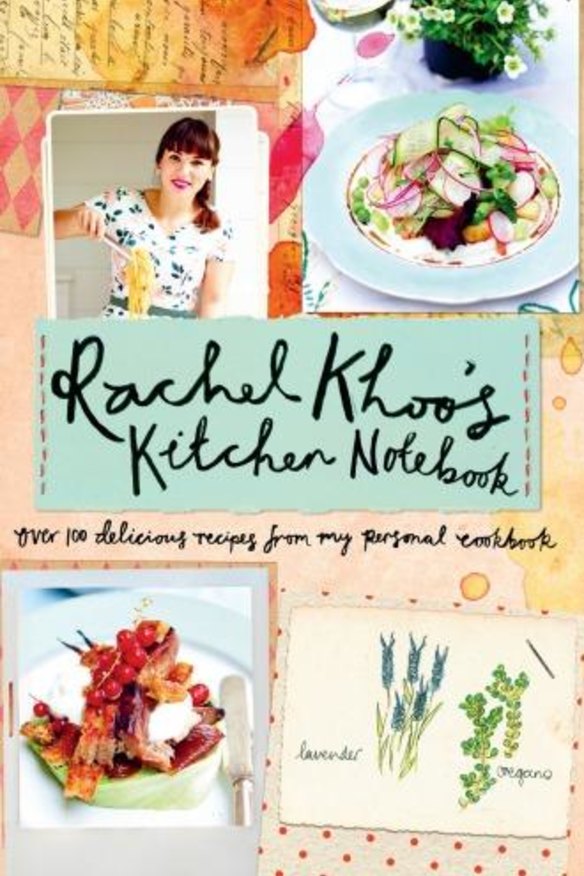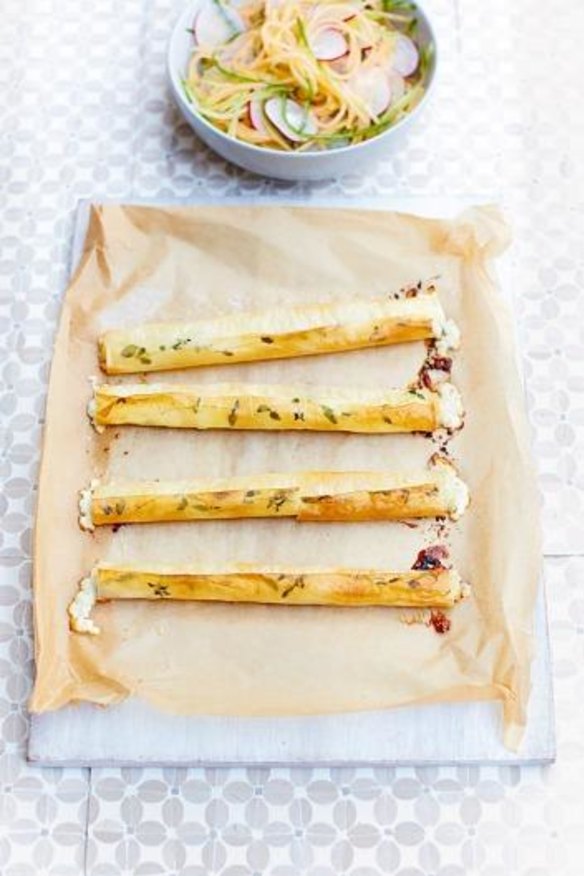Dinner party recipes from Rachel Khoo's Kitchen Notebook

Baked goat's cheese cigars with melon, radish and cucumber slaw
The Nice area tends to produce goat's cheese rather than cheese made from cow's milk, as the landscape is too rugged and rough for cows to graze. Eating goat's cheese from this region really captures the flavours of the terroir. Goats graze on whatever grows, from wild herbs like oregano and thyme to berries, and these flavours subtly influence the end product. These make a delectable summer starter or an apertif with a glass of rosé, showcasing the flavours of Provence.
Ingredients
1-2 rectangular filo sheets (depending on the size of your sheets)
60g butter, melted
8 sprigs of thyme, leaves picked
125g soft goat's cheese

4 tsp honey (lavender if possible)
For the slaw
1 small cucumber or ½ a regular cucumber

½ unripe galia melon, seeds removed
6 radishes, trimmed and sliced into thin rounds
For the dressing

1 tbsp extra virgin olive oil
½ tbsp red wine vinegar
sea salt and freshly ground pepper, to taste
Method
1. Preheat the oven to 180C (fan). Unroll a sheet of filo horizontally on your work surface. Cut the filo sheet in half lengthways and in half crossways to make four rectangles measuring approximately 15cm x 20cm. Lay them all out on the work surface, then brush the rectangles generously with butter, ensuring that about one tablespoon is saved to brush the tops.
2. Sprinkle some thyme leaves along the long length of each pastry rectangle and fold it in about 2cm to encase them. Crumble a line of goat's cheese in a line along the opposite short side of the pastry. Drizzle the honey along the goat's cheese on each pastry.
3. Starting at the goat's cheese end, roll the pastry over the cheese and all way to the thyme, sealing the join. Repeat the process to make four cigars.
4. Place on a lined baking tray and brush again with the remaining butter. Bake for 15 to 20 minutes, or until golden and crisp.
5. In the meantime, make the salad by using a mandolin or speed peeler to julienne the cucumber and the melon flesh. Place them all in a bowl with the radishes. Put the dressing ingredients into a small bowl or jam jar and mix well.
6. Once the cigars are cooked, toss your salad with the dressing and place in the centre of your plate. Serve with the cigars on top.
Tips
Filo sheets dry out really quickly. Be sure to store them in cling film. Be gentle when brushing the sheets as they can tear easily.
You can flavour the goat's cheese with any dried herbs or spices, for example cayenne pepper, smoked paprika, ground cumin or chilli, also try a spoonful of your favourite chutney or caramelised onions in place of the honey.
Serves 4 as a starter
Spice-rubbed trout
When it comes to spice rubs, I have some friends who guard their personal recipe the same way Coca-Cola guard theirs. I, however, am happy to share my special blend of spices. Making your own custom spice rub is probably the simplest way of adding your own personal touch to dishes. This recipe is really just a starting point and can be easily adapted to your taste. Once you get the hang of balancing the flavours, the possibilities are endless.
Ingredients
4 whole trout (approx. 300g each), gutted and scaled
1½ unwaxed lemons
1 small bulb of fennel (250g), halved and finely sliced, keeping the leafy tops
a large handful of fresh flat-leaf parsley leaves, roughly chopped
200g giant couscous
250g French green beans, trimmed and cut into 1cm rounds
1 tbsp olive oil
sea salt
For the spice rub
2 tbsp sumac
1 tbsp smoked paprika
1 tbsp sugar
1 tbsp sea salt
1 tbsp ground cumin
½ tbsp ground ginger
½ tbsp ground cinnamon
Method
1. Preheat the grill to high. Blend the ingredients for the spice rub in a pestle and mortar.
Smear the spice rub generously all over the outside and inside of the trout, then place on a foil-lined, lightly oiled baking tray.
2. Thinly slice one of the lemons. Stuff the fennel, parsley and lemon slices inside the cavity of the fish. Place the fish under the grill. Grill for five to 10 minutes on one side, then turn the fish over and cook for a further five minutes on the other.
3. Meanwhile, bring a pot of salted water to the boil and add the giant couscous. Boil for three minutes, then add the French green beans. Cook for a further two minutes, or until al dente, and drain.
4. Zest and juice the remaining ½ a lemon. Toss the beans with the oil, lemon zest and juice and a little salt. Serve each fish whole with the couscous on the side. Garnish with the leafy fennel tops.
Tip
This spice rub works well with all sorts of other things. Try spreading it on aubergine slices and drizzling with a little oil before grilling. It's also a great rub for chicken.
Get ahead
Make the spice rub a few days before and keep in a sealed jar. You can easily double the quantity and store it to season other dishes.
Serves 4
Lemon lava cake
What do you get when you cross an Amalfi lemon, Vesuvius and a cake? A lemon lava cake! OK, I know my joke is appalling, but that's how I got the idea for this recipe. The Amalfi coast is blessed with an abundance of citrus fruit, which line the coastal roads that cling to the cliffs. This little cake erupts like the nearby Mount Vesuvius, with a zingy hot lemon curd. It's dessert with attitude: a punchy lemon flavour and an exploding centre.
Ingredients
For the lemon curd
juice of 3 lemons (approx 110ml)
200g castor sugar
2 eggs
a pinch of sea salt
50g cold unsalted butter, cubed
For the sponge
100g soft unsalted butter, plus extra to grease ramekins
80g castor sugar, plus 1 tbsp to dust ramekins
2 eggs
2 tbsp whole milk
zest of 3 unwaxed lemons
100g plain flour
Method
1. Place all the ingredients for the lemon curd, apart from the butter, in a medium saucepan on a gentle heat and whisk continuously for five to eight minutes, or until the mixture thickens. Whisk in the butter, cube by cube. Take off the heat once all the butter has dissolved. Pour into a wide bowl and cool for around 20 to 30 minutes, or until room temperature. Pour into a disposable piping bag or a heavyduty food bag, and refrigerate until using.
2. Preheat the oven to 180C (fan). Butter the ramekins and dust with sugar.
3. To make the sponge, beat the butter and sugar until fluffy. Lightly beat the eggs and gradually add them to the mix, beating all the time, followed by the milk and lemon zest. Sift the flour into the mix and incorporate well. Divide the cake batter between the ramekins until just over half full. Take the piping or food bag and snip off the corner. Insert the tip into the centre of each batter-filled ramekin. Pipe the curd into each one until the ramekins are two-thirds full. Place on a baking tray.
4. Bake for 15 to 20 minutes, or until the tops are golden and spring back when touched.
5. Immediately run a knife around the edges of the cakes before turning out from the ramekins on to plates. Serve straight away.
Makes 6
Tips
Make sure not to let the curd boil, as this will make it split and give it an eggy taste. The leftover lemon curd is delicious swirled into yoghurt.
Get ahead
You can bake these from frozen. Simply fill the ramekins as in the recipe and place in the freezer. Preheat the oven to 170C (fan) and cook for about 25 minutes.
Recipes extracted from Rachel Khoo's Kitchen Notebook, by Rachel Khoo, published by Penguin Books, $39.99.
The best recipes from Australia's leading chefs straight to your inbox.
Sign up